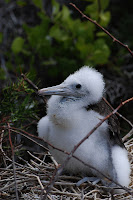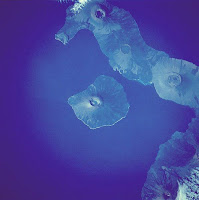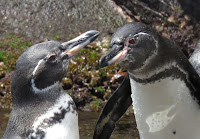 Our islands are blessed to be the indigenous home of the Galapagos Penguin. This is the only species of penguin that lives above the Equator. They are able to do so because of the cool water temperatures that result from the Cromwell Currents. There are “warm water” Humboldt penguins along the coasts of continental Ecuador, Chile and Peru, but they do not go north of the Equator.
Our islands are blessed to be the indigenous home of the Galapagos Penguin. This is the only species of penguin that lives above the Equator. They are able to do so because of the cool water temperatures that result from the Cromwell Currents. There are “warm water” Humboldt penguins along the coasts of continental Ecuador, Chile and Peru, but they do not go north of the Equator. Friday, 24 August 2012
Penquins on the Equator
 Our islands are blessed to be the indigenous home of the Galapagos Penguin. This is the only species of penguin that lives above the Equator. They are able to do so because of the cool water temperatures that result from the Cromwell Currents. There are “warm water” Humboldt penguins along the coasts of continental Ecuador, Chile and Peru, but they do not go north of the Equator.
Our islands are blessed to be the indigenous home of the Galapagos Penguin. This is the only species of penguin that lives above the Equator. They are able to do so because of the cool water temperatures that result from the Cromwell Currents. There are “warm water” Humboldt penguins along the coasts of continental Ecuador, Chile and Peru, but they do not go north of the Equator.
Labels:
About the Galapagos Islands,
penquins,
Wild Life
Sunday, 19 August 2012
Genovesa (Tower) Island Visitor Sites
 |
| Genovesa Island - Darwin Bay Photograph from Galapagos National Park Service |
 |
| Frigate Bird Chic |
Monday, 13 August 2012
Floreana Island
 |
| Sorting the Mail at the Post Office on Floreana Island |
Post Office Bay and Floreana Post Office
 |
| Evidence of Previous Visitors to the Post Office |
Thursday, 9 August 2012
Fernandina Island - Espinosa Point and Mangle Point
 |
| Fernandina on the Left; Isabela on the Right Photograph From WikiCommons |
 |
| Fernandina's Core Erupting in 2009 from Nasa Image |
Labels:
Espinosa Point,
Fernandina,
Mangle Point,
Tourist Sites,
Travel,
Visitor Sites
Bartolome Island - Pinnacle Rock and Beautiful Beaches
 |
| Bartolome Island; Pinnacle Rock Photographed by AquaSurround |
 |
| Steps on Bartolome with Galapagos Hawk Above Photograph by AquaSurround |
Labels:
Bartolome Island,
Pinnacle Rock,
Tourist Sites,
Travel,
Visitor Sites
Wednesday, 8 August 2012
Galapagos Islands - An Overview and Visitor Site Information
Where are the Galapagos Islands? What are The Visitor Highlights?
 |
| Galapagos Islands Map From Wiki |
This post is meant to help you with these and many more questions. Here, I provide you with an overview of visitation to each of the Galapagos Islands, with some of their natural history and geography, along with the visitor site highlights of each Island. In addition, as I continue to blog about the Galapagos Islands, I will add links to detailed information about each site. As always, if you have questions, or you want more detail about anything mentioned in this article, please email me at blueattraction@hotmail.com.
The video below, by Alex Hantke of Aquasurround is one of the most beautiful you will ever see of the magnificent wild life, bird life and marine life you can expect to see when you visit the Galapagos Islands. It is a perfect introduction. Click here to see more of Alex's videos.
The Galapagos Islands are located about 600 miles off of the Pacific Coast of continental Ecuador. Though counted in different ways, they consist generally of 15 primary islands, 3-4 smaller islands and more than 100 rocks and islets.
Subscribe to:
Posts (Atom)

